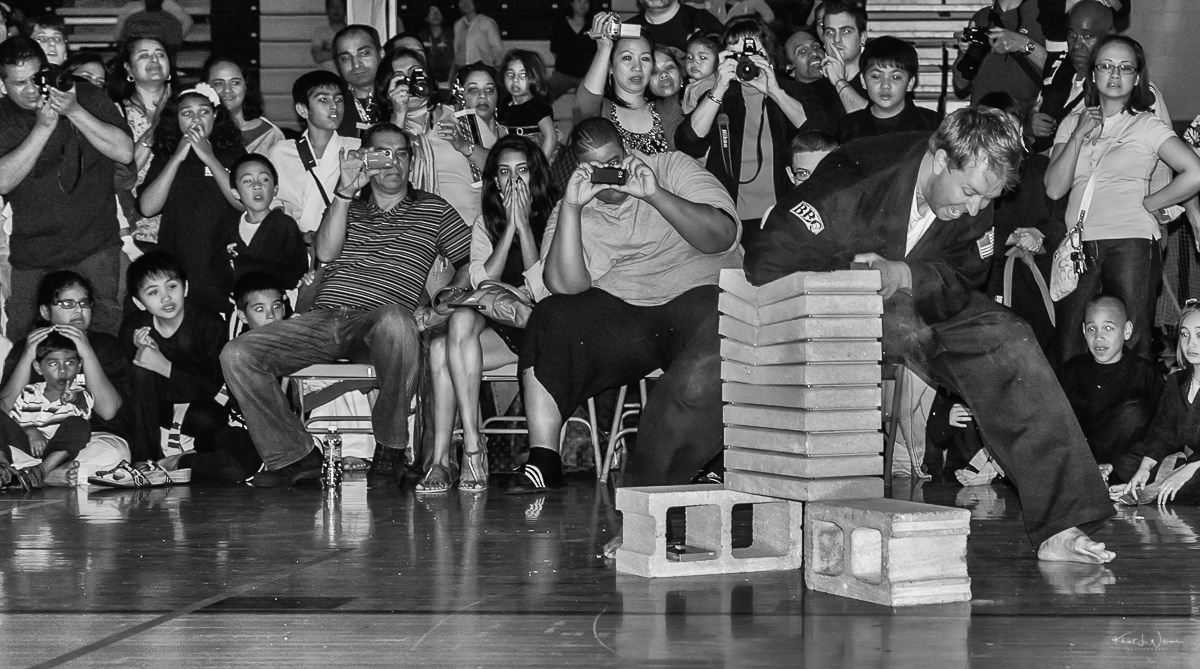Action photography often means shooting in shutter priority mode which in many cases means a high shutter speed to freeze the action.
In 2011, my kids competed in the New Jersey Martial Arts Alliance (NJMAA) Invitational Championships. I showed up at the event with my Nikon D40 and my trusty Nikkor 35mm f/1.8 and Nikkor 18-55mm f/3.5-5.6 VR. With the yellowish subdued lighting in the North Hunterdon High School gym, I was not expecting to get any good shots. Near the end of the day, John Kanabay, the instructor and owner of Montgomery Martial Arts in Skillman approached me about taking photos. He was doing a demo in the late afternoon and he was attempting to break ten bricks at once. The previous year, he had successfully broken seven bricks.
He stated:
You took some great photos last year. Do you mind taking some photos when I do the demo?
No pressure! I told him I would do my best given that I did not have the right equipment.
I spent the next half hour fiddling with my camera as the other black belts performed. I tested every combination of shutter and aperture priority - with and without flash - that I could think off. Nothing looked good to me. Then I saw the “M”. I said to myself, “What the heck. It’s worth a try”. I practised a few more shots in manual mode trying to dial in the correct setting on the camera.
Action photography often means shooting in shutter priority mode which in many cases means a high shutter speed to freeze the action. If the lighting is poor, it could also mean shooting in high ISO with a wide aperture.
In 2011, my kids competed in the New Jersey Martial Arts Alliance (NJMAA) Invitational Championships. I showed up at the event with my Nikon D40 and my trusty Nikkor 35mm f/1.8 and Nikkor 18-55mm f/3.5-5.6 VR. With the yellowish subdued lighting in the North Hunterdon High School gym, I was not expecting to get good shots.
Near the end of the event, John Kanabay, the instructor and owner of Kickside Martial Arts (then Montgomery Martial Arts) approached me about taking photos of his demo. He was doing a demo in the late afternoon and he was attempting to break ten cement bricks at once. The previous year, he had successfully broken seven bricks. He had never attempted this many bricks.
”You took some great photos last year. Do you mind taking some photos when I do the demo?”
I was excited. I told I was still learning how to shoot action. I assured him that I would do my best given that I did not have the right equipment.
For the next thirty minutes, while the other black belts performed, I fiddled with the ISO, aperture and shutter speed settings on my camera. I tested every combination of shutter and aperture priority, with and without flash, that I could think off. From the back of the LCD, nothing looked good to me. Then I saw the “M”.
“What the heck”, I said to myself. ”It’s worth a try.”. I practised a few more shots in manual mode trying to dial in the correct setting on the camera.
The moment came. I had to make sure that I could time my shot at the moment just beyond which his elbow made contact with the first block. I took the shot at 1⁄500 s at f/2.8 and ISO 320. The result was not what I expect.
Mr. “K” (that’s what the kids call him) got five of the ten bricks and I got a mostly in focus shot. But … just like Mr. “K”, I had pushed myself beyond what I had done before. I was liberated from self-imposed thoughts about my abilities.
At that moment, I felt that I have crossed a point in the learning process where I could take off the training wheels. Over the years, I continued to practice timing my shots to capture the action. I observed the Tae Kwon Do tournament competitors learning how to anticipate the moment when their feet, arms, and legs would make contact with boards, bricks and other competitors.
The moment came. I had to make sure that I could time my shot at the moment just beyond which his elbow made contact with the first block. I took the shot (1/500 s at f/2.8 ISO 320). It was not what we both had expected. Mr. “K” (that’s what the kids call him) got five of the ten bricks and I got a mostly in focus shot. But … just like Mr. “K”, I had pushed myself beyond what I had done before. I was liberated from self-imposed thoughts about my abilities.


At that moment, I felt that I have crossed a point in the learning process where I could take off the training wheels. Over the years, I attend more Tae Kwon Do tournaments and observed the black belts. I learned to anticipate the moment when their arms, legs and feed would make contact with the wooden board and cements blocks. I improved the timing of my photographs. My skills got better and so did Mr Kanabay’s.


In 2015 John Kanabay was the North American Sports Karate Association (NASKA) World Top 10 Black Belt in Martial Arts and in 2016 he was International Sport Karate Association (ISKA) World Breaking Champion 2016.

